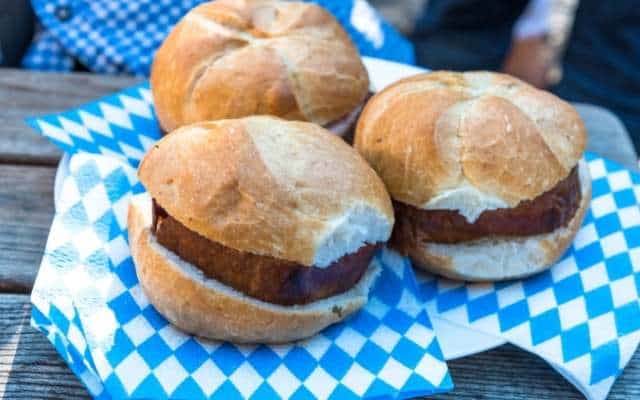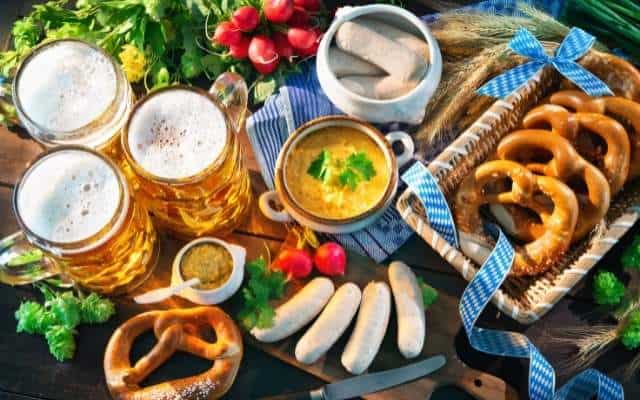Bavarian Cuisine can be classified as being hearty, plentiful and generally rich of flavour.
In recent years Munich has seen a boom in Haute Cuisine but generally, subtlety in Bavarian cooking is not something you’d usually associate with any Bavarian dish.
With Bavaria sporting such a cool climate, it’s no surprise that the resultant Bavarian Cuisine relies heavily on root vegetables, roasted meats, and flour based dished.
Bavarian Cuisine was developed through a regional collection of local specialties compiled specifically for presentation to the Royal Court, but its roots lie with dishes inspired from Czech, French, and Austrian and even with a little Chinese influence thrown in.
In this article we’ll examine and highlight the history, traditions and development of Bavarian Cuisine, and we’ll outline some of the more well-known Bavarian dishes you’d find served in Munich today.

A Brief History of Bavarian Cuisine
Whilst it’s true that medieval cooking traditions form the basis of most Bavarian dishes, it’s also evident that conquerors such as Charlemagne (King if the Franks) were instrumental in influencing the style.
Whilst not proven, it’s widely accepted as knowledge, that is was Marco Polo who bought traditional Chinese style noodles from the far-east to Western Europe. What’s not widely known is that it’s also supposed that the famous Venetian Explorer brought with him the recipe for what has become the famous Bavarian Knödel (a type of bread-based boiled dumpling), on his travel from China.
Napoleon himself had a hand in the evolution of food-preparation during the Napoleonic Wars, and even the magical beverage of beer itself has been a contributing factor to development of food, cooking and cuisine in Bavaria.
Without doubt, however, it was the powerful Royal Bavarian Dynasty of rulers from the House of Wittelsbach that had the majority of the influence over what constitutes as Bavarian Cuisine today.
The ruling Wittelsbach Royals wanted to move away from the old style of Bavarian cookery, which was seen to be more “working-class”, and they “refined” the cuisine so as to be accepted at their Royal Court by all their suitors.
Bavarian Cuisine has a long and eclectic history and has now developed into one of the most recognisable styles of food preparation in Germany and throughout Europe.
What is Typical Bavarian Food?
Sausages, roasted or grilled meats such as Schweinshaxe (roast pork knuckle), and chicken or turkey based dishes are generally at the centre of most Bavarian meals. Many of these dishes will be complimented with root vegetables such as potato, carrots or cabbage, all of which grow easily in the cooler climates.
Thick hearty stews of rich gravy, and a plethora of different types of dumplings (both savoury and sweet), can be found on most Bavarian menus.
Bread, as in most cuisines, plays a big part of Bavarian life and in fact the Bavarians even invented their own snack, Brotzeit, which is to be eaten between breakfast (Frühstück) and lunch (Mittagessen).

What is a Typical Bavarian Breakfast?
A Bavarian Breakfast (das Bayerische Frühstück), as you might expect, will differ greatly from what you‘d be served up if visiting Bavaria as a tourist.
Of course, not all Bavarians eat a breakfast like this every day and indeed most, in this modern world we live, would not. But in terms of being traditionally and authentically Bavarian, you can’t go past this version of Bavarian breakfast.
The typical and traditional Bavarian Breakfast consists of just four things:
Brezen
Otherwise known as “pretzel” by tourists this salty bread like baked snack, is usually soft inside and has a crunchy (ish) exterior. Brezen is actually served with most meals in Bavaria and is not exclusive to breakfast. Sometimes, a Bavarian breakfast may be served with just Brot (bread) or Brötchen (bread roll), but the traditional way will always include Brezen.
Weisswurst (German Weißwurst or White sausage)
This boiled white sausage was the creation of a Munich Butcher back in 1857 during the Munich festival of Fasching. It has since has become one of the biggest selling meat based products in Bavaria. Made of veal, bacon and seasonings the Weißwurst is often actually served in pairs and one should not eat the casing of the sausage but instead slice the skin to reveal the inner contents of the sausage or, as real traditionalist would have it, suck the meat out through the end of the Weisswurst.
Bavarian Sweet Mustard – Bayerischer Süßer Senf
Used as a condiment for Die Weißwurst, this delicious sweet mustard is usually made from beer and honey and can also be found at lunch and dinner tables to be enjoyed with other Bavarian delicacies such as Leberkäs. You’ll find a lot of Bavarians like to dip their Brezen into this sweet mustard as well, and it’s also used regularly as a spread in sandwiches.
Beer – Weißbier (Wheat beer)
It’s not for us to judge who has what for breakfast, and certainly from our point of view, drinking a beer at breakfast is more than acceptable when consumed the right way. Overindulgence is never a part of a typical Bavarian breakfast, so enjoying your weisswurst and Brezen in the traditional way, with a wheat beer, is highly recommended. A quality Weißbier should have a generous thick head of froth and have a strong malty flavour to compliment the richness of the white sausage and Senf.

Bavarian Cuisine: Lunch (Mittagessen) & Dinner (Abendessen)
Bavarian food is serious, very serious! Packed full of taste, Bavarian culinary offerings are designed to “smack you in the face” with flavour. Most options are rich, filling and include some sort of dough aspect to their fare, obviously to help soak up that AWESOME Bavarian beer which is also served with most meals.
Here is our list of our favourite Bavarian dishes that you’ll find on offer on most Bavarian restaurants menus for lunch or dinner.
- Schweinshaxe – Pork Knuckle
This is a slow-roasted cut of pork from the leg of the pig that is usually rubbed in salt to create a crispy “crackling” and a juicy tender meat interior bursting with flavour. - Knödel – Dumplings
Not so much a main dish but utilised widely as an accompaniment to most main Bavarian dishes. Either boiled or steamed, these delicious bread (or potato) based delicacies are made by mixing day-old bread with milk and seasonings (onion, parsley, nutmeg etc) - Schnitzel – Crumbed Fried Cutlet
Bavarians will schnitzel just about anything. Veal, Pork, Beef, Chicken, Turkey and more recent time vegetarian options made with Aubergine or even pineapple! The traditional Bavarian schnitzel has to be fried in butter (or a butter, oil mix), and this makes all the difference to the flavour. - Spaetzle – Bavarian Noodles
Noodles as you know might know them are pathetic! Spätzle on the other hand, which are made from eggs, flour and salt, pack a punch that any normal noodle would run from. Usually served as a side to gravy based meat dishes, Spätzle can also be served as a main dish, most commonly with cheese as a topping and known as käsespätzle, the noodles would be topped with fried onion and parsley. - Leberkäsesemmel – Meat loaf in bread roll
This is more of a “take away” specialty and is found far and wide in Bavaria. Most Bavarian bakeries will have hot sections that offer Leberkäsesemmel as a staple and in many cases this is served with sweet mustard (Süßer Senf). Simple, satisfying and delicious. - Pichelsteiner – Bavarian Stew
Usually made of a mix of meats such as pork, beef and mutton this hearty winter stew is cooked in a meat broth with vegetables such as potato, carrot and cabbage.

Bavarian Cuisine Fun Facts
- Weisswurst should not be eaten after noon. As the saying goes “Weißwurst should not hear the noon bells chime”
- Frühschoppen – This is actually a word for describing the act of drinking beer (or wine) in the morning as part of a snack or late Frühstück
- Bavarian’s eat more veal than in any other place on the planet with veal dishes found on menus for breakfast, lunch and dinner
- November 27th is National Bavarian Cream Pie Day. True story! There is a day dedicated just to cream pies.
- Rollmops which are pickled fish rolls made of herring fillets and are known as being a popular hangover cure.
- Kaffee is the equivalent of the British “tea time”. Bavarians, and Germans in general, aren’t big on beer but coffee, well that’s another matter
- Mainfränkische Meterbratwurst, or the one-metre long sausage, was made famous in 1953 in Northern Bavaria by butcher Lawrence Stark. This thin sausage is also regularly served in half-metre amounts (as you can find at Oktoberfest) and is often a part of food eating contests in the German state.
Bavaria offers over 400 different types of cheeses with over 100 different flavours with one particular pastoral region in the south of Bavaria, Allgäu, known as the “Land of Cheese”
Bavarian Cuisine – Not for the Faint of Heart!
There you have it, our take on Bavarian Cuisine. The food from this region is Big, Bold, and Brazen. Subtle wimpy food this is not!
There is obviously so much more that could be incorporated into any blog post on Bavarin Food so we will be writing dozens of smaller blog entries on the different types of Bavarian Foods and what they mean so STAY TUNED!
To find out more about food retailers in Munich and their Green Initiatives please do check out this recent article.
What’s your favourite type of Bavarian Cuisine – we’d love to hear from you!
Take care and Guten Appetit
Other Bavarian Dishes you'll Want to Try
Steckerlfisch is one of the main types of fish delicacies they serve in Bavaria. This is fish grilled on a stick in style.

